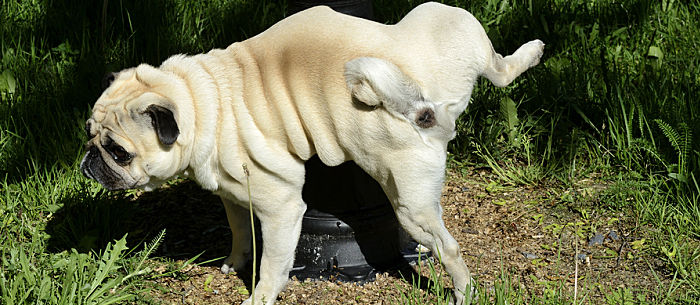If you notice your dog peeing more than usual, drinking copious amounts of water or you feel like he’s “just not himself,” it could be kidney failure. It’s time to pay a visit to your vet. “The sooner the signs of kidney failure in dogs are recognized, the earlier the diagnosis of kidney disease can be made and the easier we can slow down the progression of the disease,” says veterinarian Dr. JD Foster, a diplomate of the American College of Veterinary Internal Medicine and a co-director of the Comprehensive Urology and Nephrology program at PennVet.
Kidney disease can look innocuous, can have the same signs as other diseases or sometimes have no recognizable symptoms at all, so it’s important to get a vet’s input about what is happening. “The only way to diagnose kidney failure properly in dogs is to get proper lab work done,” says Dr. Kimberly Hammer, a veterinarian at NorthStar VETS in Robbinsville, New Jersey, and a diplomate of the American College of Veterinary Internal Medicine. “Once the blood work comes back positive for kidney failure, we have already lost 75 percent of kidney function, so the sooner we can find out, the better.”
Two Types of Kidney Failure
Kidney (renal) failure occurs when a dog’s kidneys aren’t able to do their job, which is to remove toxins from the dog’s body. There are two types of kidney failure: acute and chronic. According to Dr. Foster, acute kidney failure is often sudden and progresses rapidly, while chronic kidney disease takes much longer to manifest. “Acute kidney failure can be due to injury or decreased blood flow to the body.
Or toxins can cause acute kidney injury,” says Dr. Foster. “We really try to treat those underlying causes to give the best chance for recovery.” Chronic kidney disease is usually congenital, but not always, he notes.
Dogs have two kidneys located within the abdomen along the spine, atop the bladder. “The kidney is entirely responsible for maintaining the entire body’s homeostasis, which includes water balance, balancing electrolytes and maintaining blood pressure,” explains Dr. Foster.
The kidneys aren’t just responsible for producing urine, but also for regulating these systems. “Urine is just a byproduct of all the other functions that the kidney does. So when we see problems with the kidneys, all of these areas can be affected, included digestion and metabolism,” says Foster.
10 Signs of Kidney Failure in Dogs
- A Sudden Change in Your Dog’s Well-Being
“When your dog is suddenly acting very sick, this could mean acute kidney injury, but it might not be. There can be many reasons why dogs suddenly seem very sick,” says Dr. Foster. A trip to the emergency vet is vital when sudden changes occur.
- Your Dog is Urinating More Frequently
This can be one of the first signs of acute or chronic kidney disease. “If you find yourself having to take your dog out for a pee more frequently, keep track,” says Dr. Hammer.
- A Decreased Appetite
“If your dog suddenly does not want to eat, is anorexic and seems generally unwell, this could mean acute kidney failure,” warns Dr. Foster. “If your dog seems to lose interest in his usual dog food and will only eat scraps and treats, this could signal chronic kidney failure.”
- Vomiting
If your dog is suddenly vomiting, especially when accompanied by not eating, this could signal acute or chronic kidney failure.
- Extreme Lethargy
“If your dog just seems really tired, unwell and does not want to do anything, this might signal acute kidney injury, especially if accompanied by recent trauma to the kidney area,” says Dr. Foster. And if you notice your happy, healthy dog getting more and more tired over time, this could indicate chronic kidney failure, he warns.
- Excessive Thirst
“If you find yourself needing to fill the water bowl up more frequently, or find your dog looking for extra water sources, this could signal chronic kidney failure,” says Dr. Hammer.
- Bad Breath
Pets might “start to develop bad breath (that is quite noticeable) due to the toxins accumulated in their bodies,” says Dr. Hammer.
- Changes to Your Dog’s Bone Structures
“They might develop a swelling on both sides of their face along the upper jaw, which is a complication of imbalances in their bodies,” says Dr. Foster. “This isn’t common but could raise a red flag.”
- Diarrhea or Constipation
Because the kidneys regulate the fluids in the body, you might see issues and changes concerning your dog’s bowel movements.
- Very Little or No Urine Production
This can occur in the very late stages of kidney failure, where urine output can decrease or stop altogether.
If you observe any of these signs in your dog, be sure to contact your vet and schedule a checkup ASAP.
For more about dog kidney disease, read Prevent and Detect Dog Kidney Failure with These 6 Tips.
Amy Aitman is a freelance writer with a passion for the four-legged creatures in this world, especially her 13-year-old Westie named Buckles. Follow her on Twitter.
*This article is for general informational purposes only. It is not intended nor implied to be providing medical advice and is not a substitute for such advice. The reader should always consult a health care provider concerning any medical condition or treatment plan. Neither Care.com nor the author assumes any responsibility or liability with respect to use of any information contained herein.

